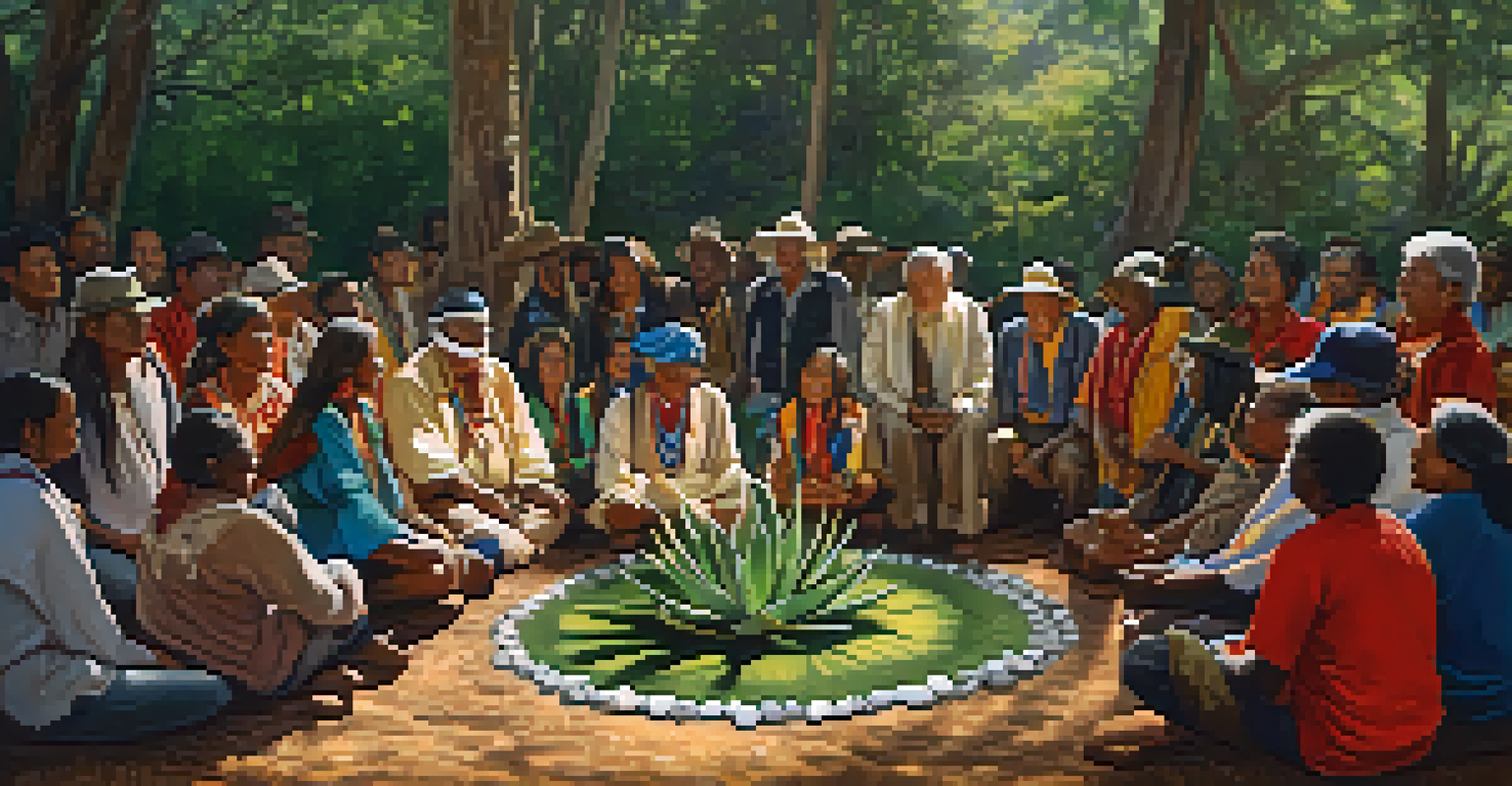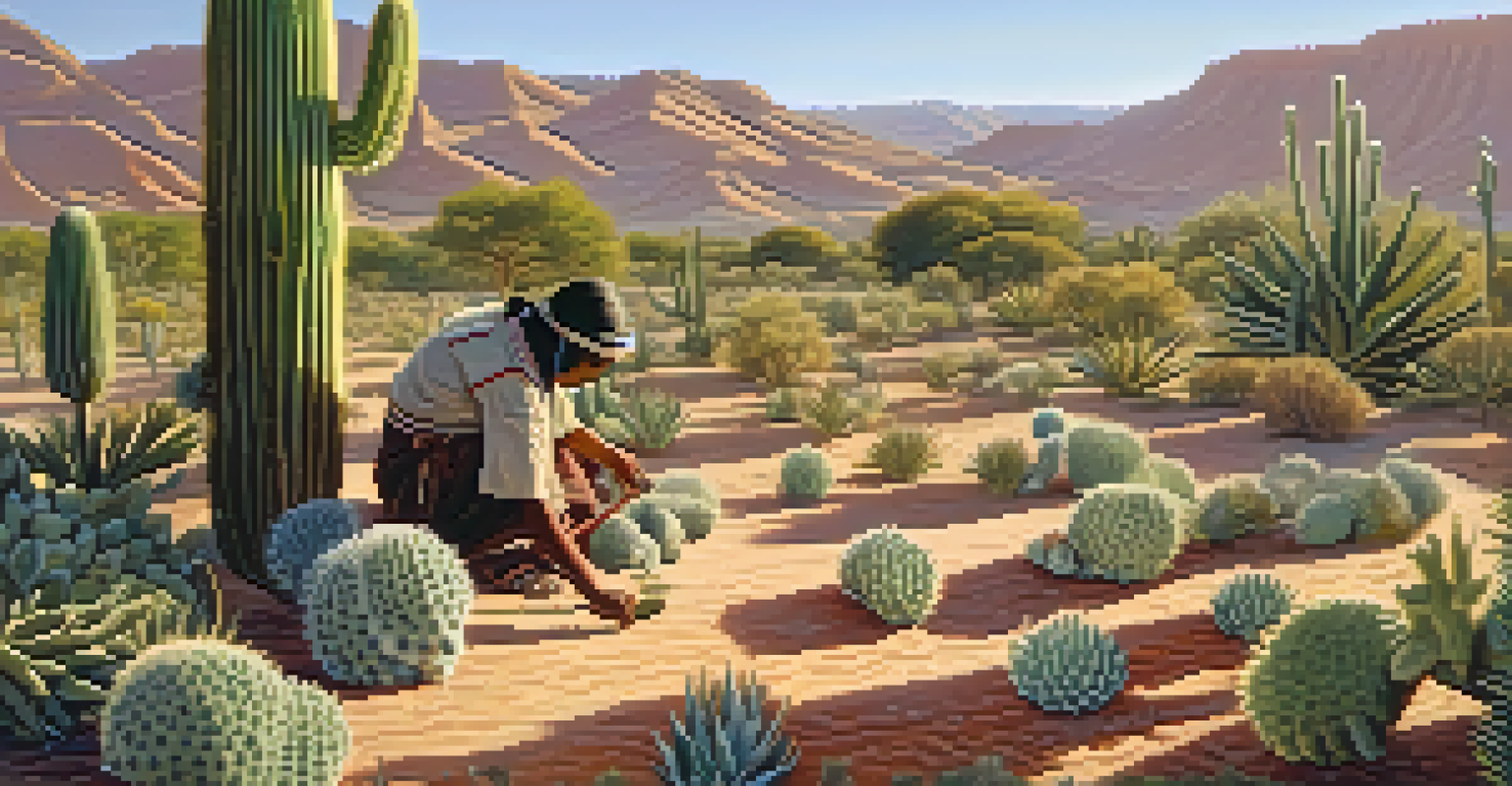Integrating Traditional Knowledge in Peyote Conservation Strategies

Understanding Peyote and Its Cultural Significance
Peyote, a small cactus native to Mexico and the southwestern United States, holds profound cultural significance for various Indigenous communities. Known scientifically as Lophophora williamsii, this plant is not just a botanical specimen; it is a sacred element in numerous spiritual practices. For many tribes, peyote serves as a vital tool for connection with the divine, aiding in rituals and healing ceremonies.
Indigenous peoples have a deep understanding of their local ecosystems that has been developed over thousands of years, which is essential for effective conservation.
The historical use of peyote dates back thousands of years, showcasing its importance in traditional medicine and spiritual practices. Indigenous peoples regard the cactus as a gift from the earth, emphasizing its role in fostering community and cultural identity. This deep-rooted relationship underlines the urgent need for conservation efforts that respect and incorporate these traditional values.
However, as modern society faces environmental challenges, the pressures on peyote populations have intensified. Habitat loss, overharvesting, and climate change threaten the survival of this significant plant. To ensure its preservation, it's crucial to acknowledge and integrate the traditional ecological knowledge of Indigenous communities into conservation efforts.
The Role of Traditional Knowledge in Conservation
Traditional ecological knowledge (TEK) encompasses the understanding and practices developed by Indigenous peoples over generations. This knowledge offers insights into sustainable land management and biodiversity conservation, particularly in areas where peyote grows. By recognizing and valuing TEK, conservationists can enhance strategies to protect peyote habitats effectively.

For example, Indigenous practices such as controlled burns and selective harvesting have been shown to promote the health and regeneration of peyote populations. These methods, rooted in a deep understanding of local ecosystems, can help mitigate the adverse effects of modern agricultural practices and land development. Integrating such techniques can lead to more resilient environments and healthier peyote stocks.
Cultural Significance of Peyote
Peyote is a sacred cactus for Indigenous communities, serving as a vital tool for spiritual connection and cultural identity.
Moreover, involving Indigenous communities in conservation discussions fosters greater respect for their cultural heritage. This collaboration not only empowers these communities but also leads to more effective and inclusive strategies that consider the needs of both the plant and the people who cherish it.
Challenges in Integrating Traditional Knowledge
Despite the clear advantages of incorporating traditional knowledge into conservation strategies, several challenges persist. One significant hurdle is the historical marginalization of Indigenous voices in environmental discussions. This has created a gap where traditional practices are often overlooked or undervalued in favor of scientific approaches alone.
We must learn to live in harmony with nature, and that includes recognizing the wisdom of Indigenous knowledge systems.
Additionally, there is often a lack of understanding and communication between Indigenous communities and conservation organizations. Misunderstandings about traditional practices can lead to mistrust, making collaboration difficult. Building relationships based on mutual respect and understanding is essential for successful integration.
Furthermore, the rapid pace of environmental change adds another layer of complexity. Traditional knowledge systems are based on stable ecosystems, but climate change and urbanization are altering landscapes at an unprecedented rate. Adapting traditional practices to modern realities requires flexibility and innovation from both Indigenous communities and conservationists.
Case Studies: Successful Integrations of Traditional Knowledge
Several case studies highlight the successful integration of traditional knowledge into conservation efforts. For instance, in the Great Plains, Indigenous tribes have collaborated with scientists to restore buffalo populations, incorporating traditional hunting practices that align with ecological principles. This partnership has not only rejuvenated buffalo herds but also reinforced cultural ties to the land.
Another example is the use of Indigenous fire management practices in Australia, where traditional burning techniques have been employed to reduce bushfire risks and enhance biodiversity. By respecting Indigenous knowledge, these strategies have proven more effective than conventional approaches, showcasing the value of collaboration.
Value of Traditional Knowledge
Integrating traditional ecological knowledge enhances conservation strategies and promotes sustainable land management for peyote habitats.
These case studies illustrate that when traditional knowledge is recognized and integrated, both the environment and Indigenous communities benefit. The successful outcomes serve as a roadmap for similar conservation strategies focused on peyote and other culturally significant plants.
The Importance of Legal Recognition and Rights
Legal recognition of Indigenous rights is crucial for the successful integration of traditional knowledge in conservation practices. When Indigenous lands and rights are acknowledged, communities are better positioned to manage their resources sustainably. This legal framework supports the protection of peyote habitats and the promotion of responsible harvesting practices.
In many regions, Indigenous peoples have fought for their rights to land and resources, often facing significant opposition. Recognizing these rights not only helps preserve peyote populations but also affirms the cultural identity of the communities that depend on them. This legal support can lead to more effective conservation outcomes by empowering Indigenous governance.
Furthermore, creating policies that prioritize Indigenous participation in decision-making processes ensures that conservation strategies are more equitable and representative. By integrating Indigenous voices into policy discussions, we create a holistic approach that respects both the environment and the cultural significance of peyote.
Community Engagement: Building Bridges for Conservation
Community engagement is vital for fostering collaboration between conservationists and Indigenous peoples. Creating spaces for dialogue allows for the sharing of knowledge, experiences, and perspectives, ultimately leading to more effective conservation strategies. Engaging with local communities can help bridge the gap between scientific approaches and traditional practices.
For instance, organizing workshops that bring together conservationists and Indigenous leaders can facilitate the exchange of ideas and establish trust. These gatherings can highlight the importance of traditional knowledge while providing conservationists with valuable insights into local ecosystems and practices. This two-way learning process enriches conservation efforts and builds lasting partnerships.
Importance of Legal Recognition
Legal recognition of Indigenous rights is crucial for empowering communities to sustainably manage resources and preserve peyote populations.
Moreover, empowering Indigenous communities through education and resources enables them to take an active role in conservation initiatives. By investing in local capacity building, we not only enhance the effectiveness of conservation strategies but also honor the invaluable wisdom that Indigenous peoples bring to the table.
Future Directions for Peyote Conservation
Looking ahead, the future of peyote conservation hinges on a collaborative approach that respects and integrates traditional knowledge. As environmental challenges continue to escalate, the need for adaptive and inclusive strategies becomes increasingly important. By prioritizing Indigenous wisdom, we can develop more effective conservation practices that account for the unique ecological and cultural contexts of peyote.
Research and funding should focus on projects that highlight the role of traditional knowledge in conservation. This could include supporting Indigenous-led initiatives or documenting traditional practices that promote sustainable harvesting and habitat restoration. Such efforts not only contribute to the conservation of peyote but also empower Indigenous communities.

Ultimately, fostering a deep respect for traditional knowledge and a commitment to collaboration can create a more sustainable future for peyote and the cultures that cherish it. By recognizing the interconnectedness of people and the environment, we can work towards solutions that honor both the plant and its stewards.